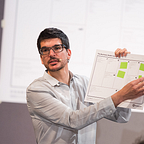How To Test Your Idea
Start With The Most Critical Hypotheses
To validate business ideas you need to perform many small experiments. At the centre of any one of these experiments should be a deep understanding of the most critical hypotheses and why you are testing them.
In the world of Lean Startup, the Build, Measure, Learn cycle is a means to an end to test the attractiveness of business ideas. Unfortunately, some innovators and entrepreneurs take the “Build” step too literally and immediately start building prototypes.
However, at the centre of the build-measure-learn cycle there is actually a step zero: shaping your idea and defining the most critical assumptions and hypotheses underlying it.
Note: I’ll be interchanging between assumptions and hypotheses throughout the rest of the post.
Step 0 — Think (& Hypothesize)
Shape your idea (product, tech, market opportunity, etc.) into an attractive customer value proposition and prototype a potential profitable and scalable business model. Use the Value Proposition & Business Model Canvas to do this. Then ask: What are the critical assumptions and hypotheses that need to be true for this to work.
Define assumptions as to:
- desirability — market risk: will customers want it?
- feasibility — tech & implementation risk: can I build/execute it?
- viability — financial risk: can I earn more money from it than it will cost me to build?
To test these assumptions/hypotheses you will perform many, many experiments. With your hypotheses mapped out, you can now start to move through the steps of the Build, Measure, Learn cycle:
Step 1 — Build
In this step you design and build the experiments that are best suited to test your assumptions? Ask: Which hypothesis will we test first and how? Ask: Which tests will yield the most valuable data and evidence?
Step 2 — Measure
In this step you actually perform the experiments. That might be through interviews and talking to a series of customers and stakeholders; by launching a landing page to see if people click on, sign up for, or even buy your (non existing because it’s not yet implemented) value proposition.
Step 3 — Learn
In this step you analyze the data and gain insights. You systematically connect the evidence and data from experiments back to the initial hypotheses, how you tested them, and what you learned. This is where you identify if your initial hypotheses were right, wrong, or still unclear. You might learn that you have to reshape your idea, to pivot, to create new hypotheses, to continue testing, or you might prove with evidence that your idea has legs and you’re on the right rack.
At the centre of all testing should always be a deep understanding of the critical hypotheses underlying how you intend to create value for customers (Value Proposition Canvas) and how you hope to create value for your company (Business Model Canvas).
I’ve seen too many innovators and entrepreneurs get lost in building experiments, but losing sight of their initial hypotheses and the ultimate prize.
At the end there’s only one thing that counts: Are you making progress in turning your initial idea into a profitable and scalable business model that creates value for customers?
Learned something? Click the 👏 to say “thanks!” and help others find this article.
This article was first published on Strategyzer.
